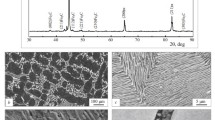Conclusions
-
1.
The structural changes in the surface layers of steel 45 when subjected to the single action of a compressed gas stream at high temperature are determined by the chemical and thermal action of the gas medium. The diffusion of the carbon and nitrogen from the gas medium extends to a depth of 10 microns and causes formation of nitrogencarbon austenite.
-
2.
High temperatures and high pressures cause secondary-quenching and high-speed tempering structures in the surface layer of the steel, which can be brought to light metallographically in the form of a poorly-etched white layer and an increased etchability zone. The thickness of the white layer decreases as the temper temperature of the initial structure of the steel is increased. The over-all depth of the structural changes is 300 microns.
-
3.
The phase composition of the white layer is determined by the distribution of temperatures over the supercritical range during high-speed heating. The structure of the high-speed high temper under conditions of external pressure differs from the structure of ordinary high tempering in its submicrostructure andα-phase crystal lattice parameter, as well as in the degree of dispersion of the carbide phase.
Similar content being viewed by others
Author information
Authors and Affiliations
Rights and permissions
About this article
Cite this article
Grozin, B.D., Nizhnik, S.B. & Yankevich, V.F. Structural changes in steel when subjected to compressed gas stream at high temperature. Met Sci Heat Treat 4, 373–375 (1962). https://doi.org/10.1007/BF00820008
Issue Date:
DOI: https://doi.org/10.1007/BF00820008




